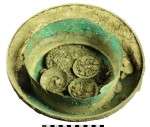 Metal detectorists discovered eight Roman copper-alloy vessels — an iron-rimmed cauldron, a deep bowl, a shallow bowl, a high-sided pot and four small scale pans — in Wiltshire’s Vale of Pewsey in October, 2014. They dug them out of the ground, unfortunately, but they did have the forethought not to clean them, a decision that ensured the survival of the pots’ incredibly rare contents. What looked like dirt and weeds was in fact ancient plant material packed in the vessel hoard when it was buried.
Metal detectorists discovered eight Roman copper-alloy vessels — an iron-rimmed cauldron, a deep bowl, a shallow bowl, a high-sided pot and four small scale pans — in Wiltshire’s Vale of Pewsey in October, 2014. They dug them out of the ground, unfortunately, but they did have the forethought not to clean them, a decision that ensured the survival of the pots’ incredibly rare contents. What looked like dirt and weeds was in fact ancient plant material packed in the vessel hoard when it was buried.
 A hoard of eight Roman pots is already a great rarity. Fewer than 30 copper alloy vessel hoards have been found from late antiquity in Britain. As small as this number is, it’s still more than have been found anywhere else in the Roman world. That the organic remains the vessels contained didn’t decay into dust makes it a unique find. The plants were preserved by the creation of an air-tight pocket inside the carefully nested pots. It was probably a fluke, a result of the way the vessels were stacked and positioned inside each other.
A hoard of eight Roman pots is already a great rarity. Fewer than 30 copper alloy vessel hoards have been found from late antiquity in Britain. As small as this number is, it’s still more than have been found anywhere else in the Roman world. That the organic remains the vessels contained didn’t decay into dust makes it a unique find. The plants were preserved by the creation of an air-tight pocket inside the carefully nested pots. It was probably a fluke, a result of the way the vessels were stacked and positioned inside each other.
 Inside the cauldron, the biggest piece, was placed the shallow bowl (Vessel A). The high-sided pot (Vessel B) with the four little scale pans inside was placed in the shallow bowl, its rounded feet raising it from direct contact with the bottom of the bowl. The deep bowl (Vessel C), of a type known as an Irchester bowl, was flipped upside-down to cover vessel B entirely and cover the rim of Vessel A. The organic remains were almost entirely contained in Vessel B. As the metal corroded over the years, the copper salts were absorbed by plant material, also helping to preserve it. The plants have a powdery consistency now because of the copper salts, but they’re microscopically identical to when they were fresh.
Inside the cauldron, the biggest piece, was placed the shallow bowl (Vessel A). The high-sided pot (Vessel B) with the four little scale pans inside was placed in the shallow bowl, its rounded feet raising it from direct contact with the bottom of the bowl. The deep bowl (Vessel C), of a type known as an Irchester bowl, was flipped upside-down to cover vessel B entirely and cover the rim of Vessel A. The organic remains were almost entirely contained in Vessel B. As the metal corroded over the years, the copper salts were absorbed by plant material, also helping to preserve it. The plants have a powdery consistency now because of the copper salts, but they’re microscopically identical to when they were fresh.
Finds Liaison Officer Richard Henry has led the exciting quest to discover more about the find. He brought in a team to excavate the site of the discovery, led by David Roberts of Historic England and with the Assistant County Archaeologist, members of the Wiltshire Archaeology Field Group and the finders. Richard then brought in more experts, including Dr Ruth Pelling of Historic England and Dr Michael Grant who identified the plant remains and pollen. Peter Marshall, also of Historic England, coordinated the radiocarbon dating of the flowers and undertook analysis of the results. […]
Richard Henry said “Such discoveries should be left in situ to allow full archaeological study of the find and its context. The finders did not clean or disturb the vessels which has allowed us to undertake detailed further research. If the vessels had been cleaned none of this research would have been possible”
Ruth Pelling commented that “It has been an absolute pleasure to examine this unique assemblage. By combining the plant macro and pollen evidence we have been able to identify the time of year the vessels were buried, the packing material used, the nature of the surrounding vegetation and the likely date of burial.”
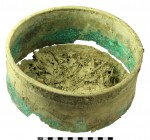 Radiocarbon dating of the plants by Historic England found they were buried between 380 and 550 A.D., a turbulent time when the Romans were in retreat or just plain gone (Emperor Honorius pulled the last legions from Britain in 410 A.D.) and the Anglo-Saxons began spreading through England from their strongholds in the south and east.
Radiocarbon dating of the plants by Historic England found they were buried between 380 and 550 A.D., a turbulent time when the Romans were in retreat or just plain gone (Emperor Honorius pulled the last legions from Britain in 410 A.D.) and the Anglo-Saxons began spreading through England from their strongholds in the south and east.
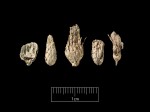 Hoards from this period are generally thought to have been buried to keep them safe from Saxon raids. Roman copper vessels were relatively common household goods during more prosperous times, but at the remote ends of empire after the collapse of Roman rule they would certainly have been hoardworthy. The plant material packed inside the vessels consists mainly of knapweed flowers (23 knapweed flowers, to be specific, two of them black knapweed) and pinnules and stem fragments of bracken. There are also cowslip, buttercup and sedge seeds. The seeds indicate the hoard was packed and buried in the mid to late summer out of doors in a location with both pasture and farmland.
Hoards from this period are generally thought to have been buried to keep them safe from Saxon raids. Roman copper vessels were relatively common household goods during more prosperous times, but at the remote ends of empire after the collapse of Roman rule they would certainly have been hoardworthy. The plant material packed inside the vessels consists mainly of knapweed flowers (23 knapweed flowers, to be specific, two of them black knapweed) and pinnules and stem fragments of bracken. There are also cowslip, buttercup and sedge seeds. The seeds indicate the hoard was packed and buried in the mid to late summer out of doors in a location with both pasture and farmland.
 Why the plant material was included is more mysterious. They could have been simple packing material. There was hay in the mix, too, so the plants may have been the far less annoying 5th century equivalent of styrofoam peanuts. They may also have been a votive offering. It’s notable that the hoard was buried on the boundary between Roman and Angle territory, a dangerous frontier at that time and a hotspot of upheaval during the transition from Roman rule, the kind of place where you would have good reason to appeal to higher powers for protection.
Why the plant material was included is more mysterious. They could have been simple packing material. There was hay in the mix, too, so the plants may have been the far less annoying 5th century equivalent of styrofoam peanuts. They may also have been a votive offering. It’s notable that the hoard was buried on the boundary between Roman and Angle territory, a dangerous frontier at that time and a hotspot of upheaval during the transition from Roman rule, the kind of place where you would have good reason to appeal to higher powers for protection.
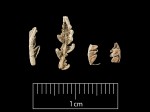 The plants and seeds were donated to the Wiltshire Museum in Devizes where they have been and will continue to be studied and analyzed. Some of the flowers are now on display at the museum. Experts were able to study the vessels, but the metal detectorists have chosen to keep them instead of donating them along with the plant materials. They can make that choice because the 1996 Treasure Act doesn’t define ancient artifacts made of base metals as treasure.
The plants and seeds were donated to the Wiltshire Museum in Devizes where they have been and will continue to be studied and analyzed. Some of the flowers are now on display at the museum. Experts were able to study the vessels, but the metal detectorists have chosen to keep them instead of donating them along with the plant materials. They can make that choice because the 1996 Treasure Act doesn’t define ancient artifacts made of base metals as treasure.
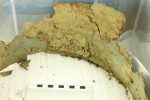 This is the same loophole that allowed the sale of the exceptional Crosby Garrett Helmet to an anonymous private collector. If there are two or more prehistoric artifacts, they count as treasure even if made of base metal. If an artifact is between prehistoric and
This is the same loophole that allowed the sale of the exceptional Crosby Garrett Helmet to an anonymous private collector. If there are two or more prehistoric artifacts, they count as treasure even if made of base metal. If an artifact is between prehistoric and 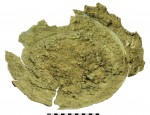 300 years old, it has to be composed of at least 10% gold or silver to qualify as treasure. It’s a nonsensical standard, particularly for archaeology where a literal bag of feces can be of inestimable value. Also, the finders can’t possibly be qualified to conserve very delicate ancient metalwork. The cauldron, for instance, is fragmentary, with the base, the little that remains of the body and the rim all in separate pieces.
300 years old, it has to be composed of at least 10% gold or silver to qualify as treasure. It’s a nonsensical standard, particularly for archaeology where a literal bag of feces can be of inestimable value. Also, the finders can’t possibly be qualified to conserve very delicate ancient metalwork. The cauldron, for instance, is fragmentary, with the base, the little that remains of the body and the rim all in separate pieces.
The plants and bronze vessels have been together for 1500+ years. As a group, they are a great archaeological treasure. I hope the finders have a change of heart and reunite these longtime companions.